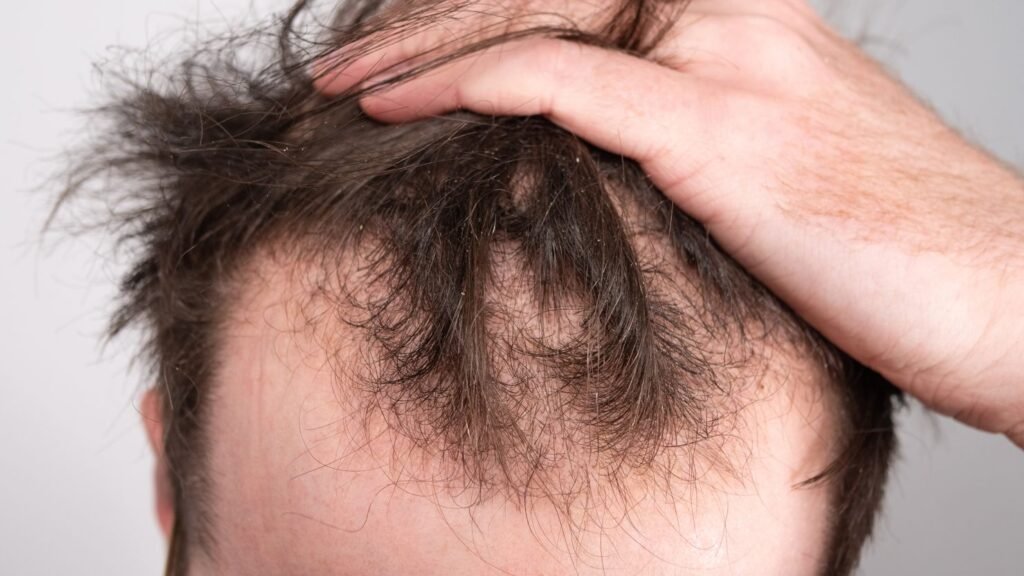Hair loss affects millions of men globally, leading to frustration and a search for effective, non-invasive treatments. Among the various options, Low-Level Laser Therapy (LLLT) has gained significant popularity as a painless, drug-free approach to stimulate hair regrowth.
In this article, we’ll explore what LLLT is, how it works, who it benefits, the treatment process, expected results, and important considerations for men looking to combat hair loss.
🌈 What Is Low-Level Laser Therapy (LLLT)?
Low-Level Laser Therapy, also called red light therapy or cold laser therapy, uses specific wavelengths of low-intensity lasers or light-emitting diodes (LEDs) to stimulate biological processes in the scalp.
Unlike high-power lasers used in surgery, LLLT is gentle and non-thermal, meaning it doesn’t heat or damage tissue. Instead, it works by promoting cellular activity at the follicle level, encouraging hair growth and reducing hair thinning.
🔬 How Does LLLT Work for Hair Regrowth?
The primary mechanism behind LLLT involves:
1. Stimulation of Hair Follicle Cells
- LLLT increases mitochondrial activity in hair follicle cells.
- Enhanced mitochondria function boosts ATP (energy) production, which fuels cell repair and growth.
2. Improved Blood Circulation
- The light energy promotes vasodilation (widening of blood vessels) in the scalp.
- Increased blood flow delivers more oxygen and nutrients to hair follicles, supporting healthier hair growth.
3. Reduction of Inflammation
- LLLT helps reduce chronic inflammation around hair follicles, a key contributor to hair loss.
- Calmer scalp environments support follicle survival and growth.
4. Activation of Dormant Hair Follicles
- The therapy may encourage resting (telogen phase) hair follicles to shift into the active growth (anagen) phase.
👨⚕️ Who Is a Good Candidate for LLLT?
LLLT is suitable for men experiencing:
- Early to moderate androgenetic alopecia (male pattern baldness)
- Diffuse thinning without complete bald patches
- Those seeking a non-invasive, drug-free treatment
- Men who want to complement other hair loss treatments such as minoxidil or finasteride
- Patients looking for a safe option with minimal side effects
💡 How Is LLLT Administered?
LLLT devices come in various forms, including:
- Laser combs and brushes
- Laser helmets and caps
- Professional clinic-based laser panels
Treatment sessions usually involve:
- Sitting or wearing the device for 15-30 minutes per session
- Frequency of 2-3 sessions per week
- Treatment durations often last from 3 to 6 months for visible results
Many men use at-home devices daily or every other day for convenience, while professional treatments may offer stronger laser intensities.
📈 Expected Results and Timeline
- Initial improvements may be seen after 8 to 12 weeks of consistent treatment.
- Hair density and thickness typically increase over 3 to 6 months.
- Continued use is necessary to maintain results, as stopping therapy may cause hair loss to resume.
- LLLT is most effective when started early in the hair loss process.
🌟 Benefits of LLLT for Men’s Hair Regrowth
- Non-invasive and painless with no downtime
- No medications or chemicals involved
- Minimal to no side effects reported
- Can be used alone or combined with other hair loss treatments
- Improves scalp health and hair follicle function
- Convenient home-use options available
⚠️ Limitations and Considerations
- Results vary; not all users experience significant regrowth
- LLLT is less effective for advanced or complete baldness
- Requires consistent, ongoing use for maintenance
- Some devices on the market lack FDA clearance—choose reputable brands
- Cost of devices and treatment sessions may be a consideration
🧠 Scientific Evidence Supporting LLLT
Several clinical studies and reviews support the effectiveness of LLLT:
- A 2014 randomized controlled trial showed significant hair density improvement in men with androgenetic alopecia after 26 weeks of LLLT.
- The FDA has cleared certain LLLT devices (like laser combs and helmets) as safe and effective for treating hair loss.
- Research indicates LLLT promotes cellular repair, angiogenesis (formation of new blood vessels), and hair follicle cycling.
🔄 Combining LLLT with Other Treatments
For enhanced outcomes, many men combine LLLT with:
- Minoxidil (Rogaine)
- Finasteride (Propecia)
- Platelet-Rich Plasma (PRP) therapy
- Hair transplant surgery
This multimodal approach targets hair loss through multiple pathways for improved regrowth and maintenance.
📝 Summary Table: LLLT for Men’s Hair Loss
| Feature | Details |
|---|---|
| Treatment type | Low-intensity red/near-infrared laser |
| Duration per session | 15–30 minutes |
| Frequency | 2–3 times per week |
| Time to see results | 8–12 weeks to 6 months |
| Suitable candidates | Early/moderate male pattern baldness |
| Side effects | Minimal to none |
| Combination with other therapies | Yes, often recommended |
| FDA clearance | Some devices FDA-cleared |
🔮 Final Thoughts
Low-Level Laser Therapy (LLLT) offers a safe, non-invasive, and scientifically backed method for men looking to combat early hair loss and stimulate hair regrowth.
If you’re interested in a pain-free option that can be conveniently used at home or in clinics, LLLT might be a great addition to your hair restoration journey. Always consult a hair loss specialist to determine if LLLT suits your specific needs and to develop an effective treatment plan.




